- Posted on March 23rd, 2022
Aphra Shemza: A case study for sustainable art practice
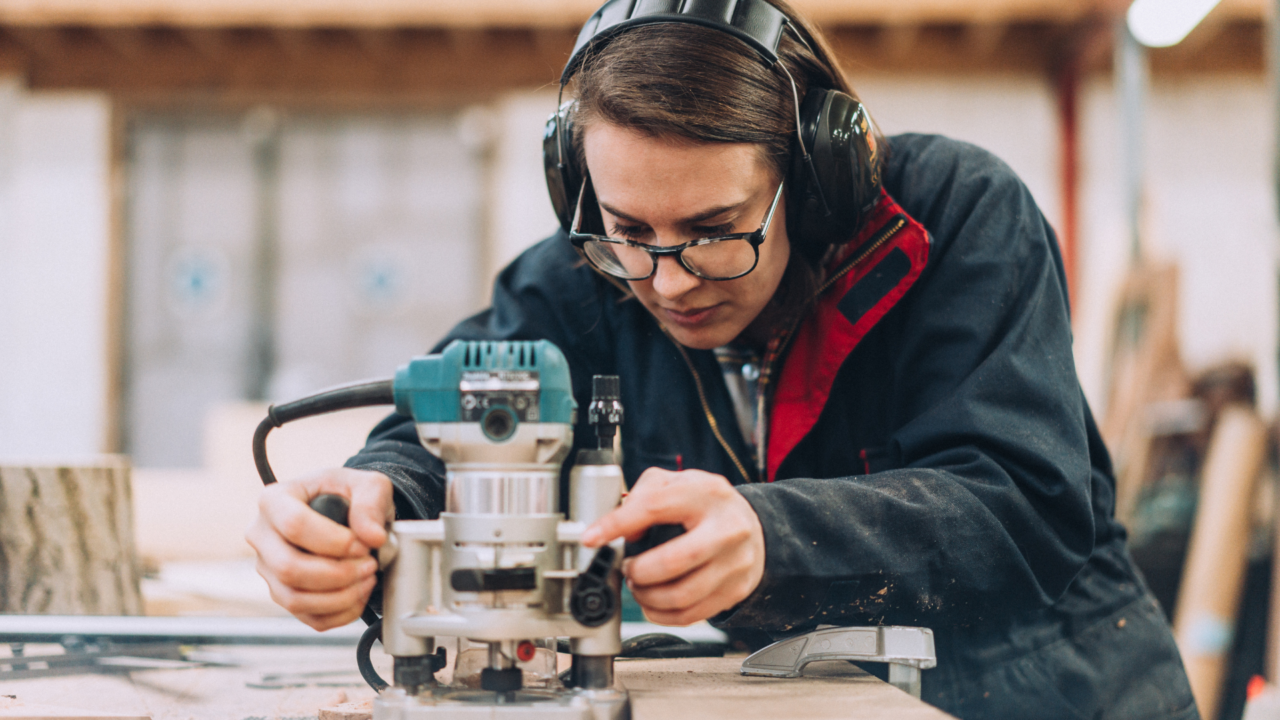
Image: Aphra Shemza at work in the studio. Photograph by Claudia Agati.
By Aphra Shemza
Aphra Shemza is a UK-based multimedia artist, Director and Curator at Art in Flux and Manager of the Estate of Anwar Jalal Shemza, her grandfather. Shemza has worked with and been commissioned by: V&A Museum, National Gallery X, Canary Wharf Group, Save the Children, Ars Electronica Festival, The Other Art Fair, The British Council, Tate Britain, The Courtauld Institute and the British Library and been featured in the Times, Timeout, Fad, Telegraph and London Live.
Introduction
I like to think of art as a tool to explore and raise questions about our human existence, the lives we lead and the society we inhabit. It is through my practice that I explore new processes and imagine alternative futures and ways of being in the world.
I am a multimedia artist. My work explores sustainable practice, modernism and creating art for all. As an artist and activist I fuse methodologies from the past with new innovations to imagine what the role of art could be in the future. Practically speaking I am a sculptor, combining traditional sculpting techniques with technology to create my pieces. Handmade and bespoke interactive circuits are embedded within my sculptures and this creates work that visualises data or responds to the viewer and the space around them.
Aphra Shemza & Julie’s Bicycle
I first came across Julie’s Bicycle when I was planning my bespoke artist development project entitled ‘Solutions for a Sustainable Art Practice’ as supported by the Arts Council of England. I found their expertise in sustainable practice and online resources incredibly useful. I specifically found the Creative Climate Movement map helpful as it allowed me to find other like-minded individuals and organisations. In the early stages I also met with Laura Pando, who was happy to impart her knowledge about potential partners and places to begin my research through her network. This was invaluable to me as it helped me to grow the project and learn more about the global context of what I wanted to do.
Solutions for a Sustainable Art Practice, 2019
‘Solutions for a Sustainable Art Practice’ was a three month artist development programme. I was artist in residence at a North London makerspace called Building Bloqs during this time. I took my two core materials of wood and plastic and learnt new skills and techniques for work with reclaimed solid timber and recycling my own plastic waste.
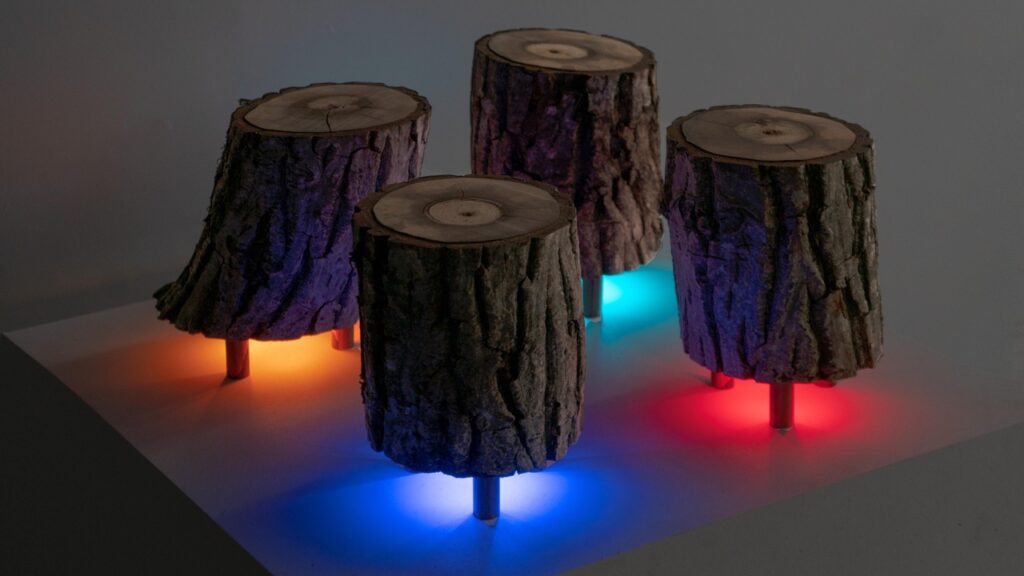
Image: Aphra Shemza, Current Climate, 2019. Photograph by Claudia Agati.
In the wood workshop I sourced my timber locally from a reclaimed supplier (Saunders Seasonings based at Blackhorse Workshop in Walthamstow, London) and worked with a master craftsman who taught me how to take rough sawn timber, plane and thickness it and work with it to create new sustainable sculptures. Current Climate, 2019 is a data visualisation work that uses reclaimed walnut and light to show the audience in real time when climate change is mentioned in selected news broadcasts.
In the plastic workshop I collected my own plastic waste and developed different DIY techniques for turning it into sheet material to create new works and imbue non-recyclable material like bubble wrap and plastic bags with a new life. My inspiration for this came from Precious Plastics, a group from the Netherlands who have proposed different open-source ways of recycling plastic locally.
With these skills, I developed a new series and started to make work about the current climate crisis, which has been a theme for me ever since. Compositions 1-4, 2019 are made from recycled bubble wrap and plastic bags.
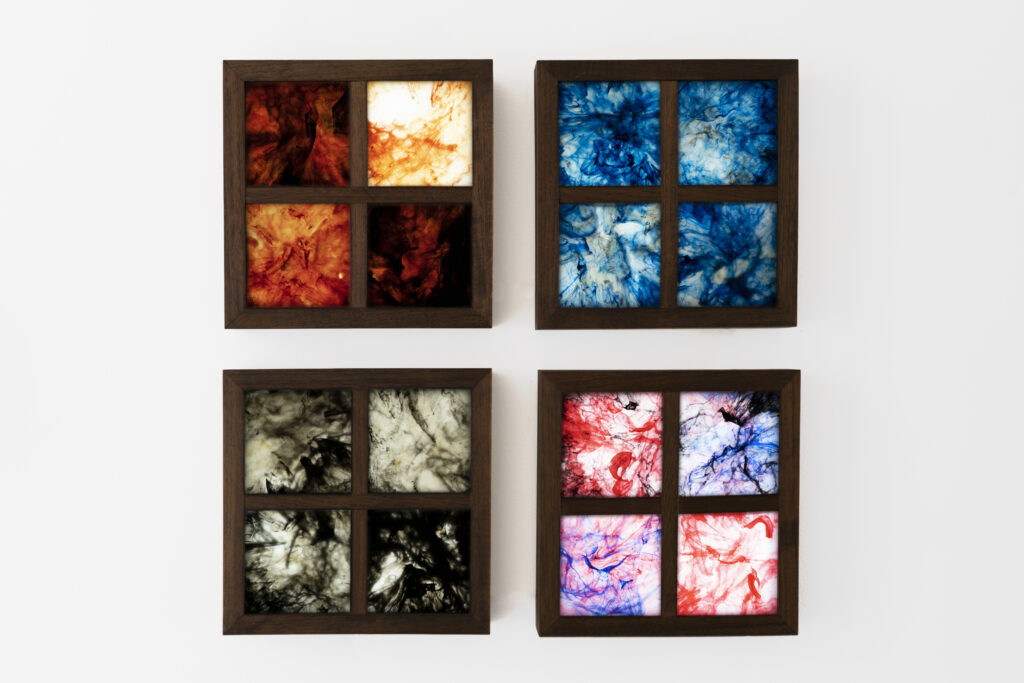
Image: Aphra Shemza, Compositions 1-4, 2019. Photograph by Claudia Agati.
Radical Ecology: Sustainable Media Art
The project culminated in an exhibition and event entitled ‘Radical Ecology: Sustainable Media Art’ in collaboration with Art in Flux, Julie’s Bicycle and Ugly Duck. The event was chaired by Laura Pando from Julie’s Bicycle and we invited Tilly Hogrebe from Bowarts, who was on the Julie’s Bicycle Accelerator Program at the time, and the artists Oskar Krajewski and Becky Lyon to speak alongside myself presenting the work and processes from my recent project.
It was great to see so many different approaches to working with art and ecology, from the complex recycled works of Oskar Krajewski to the future imaginings of biological life combined with obsolete technology in the work of Becky Lyon. The event was fully attended and our panel discussion held a healthy debate about sustainable art practice and highlighted the public’s appetite to discuss this relevant and pressing topic. View recordings of the event here.
Working sustainably moving forwards
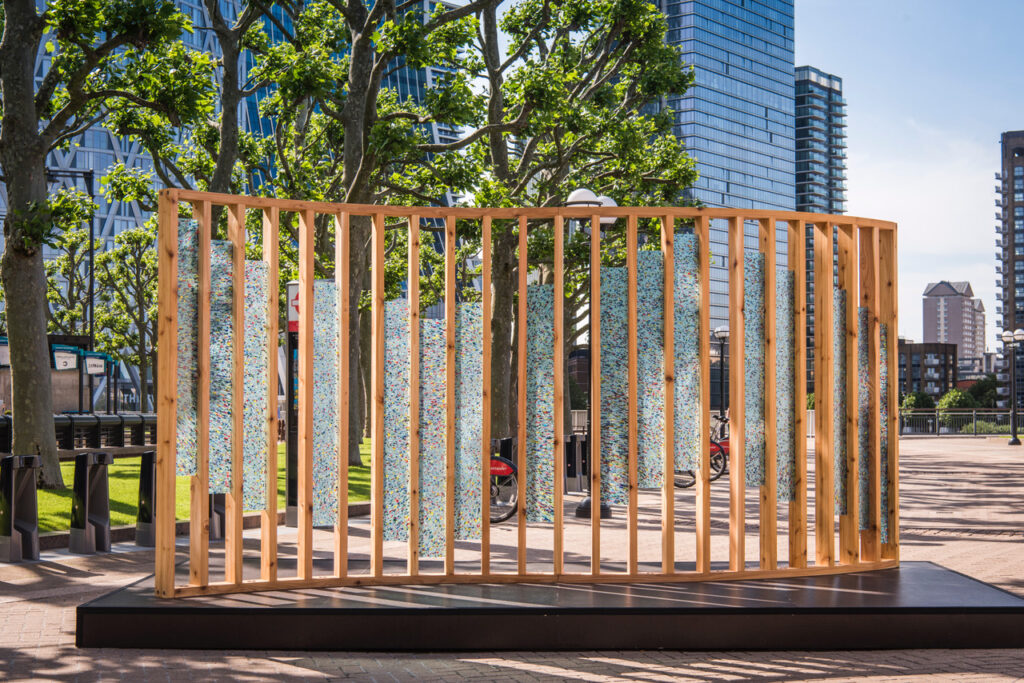
Image: Aphra Shemza, Ocean Rise, 2021. As commissioned by Canary Wharf Group for Summer Lights Festival. Sean Pollock Photography, Summer Lights 2021, Canary Wharf Arts + Events.
Since this project I have continued to work in this way to create sustainable works and raise awareness about the climate crisis. Ocean Rise, was the first public sculpture I created, commissioned by the Canary Wharf Group for the Summer Lights Festival in 2021. It is a mixed reality artwork that highlights the rise in sea levels due to global warming. Hive Mind, was a collaboration with Backstage Academy students and uses the Manchester Bee as a symbol of unity and created a recycled 3D printed sculpture to bring the participants together through interactivity. I have also been published in Dorling Kindersley’s The Artist’s Manual and the UK Green Guide by Invisible Flock. I launched Art-ology.co.uk in 2018 which is a peer resource for other artists who wish to be more mindful of their environmental impact.
Ocean Rise as funded by Arts Council England

Image: Aphra Shemza, Ocean Rise I, 2022. Photography by Matthew Kaltenborn.
In my latest project Ocean Rise, launched at the Art in Flux: Radical Ecology event at National Gallery X and funded by the Arts Council of England, I am artist in residence at Spacer, an eco artist hub based in Ramsgate.
In the UK we only recycle 10% of our plastic waste and with my practice I am looking for a solution to our plastic pollution problem. In this project I have been able to purchase two new plastic recycling machines from the Precious Plastics machine family: a shredder and sheet press to upscale my plastic recycling capabilities so that I can process more material and create larger sheets for making artworks. I have produced two new methods for recycling different plastics: HDPE (milk bottles and food containers) and LDPE (plastic bags and bubble wrap). I have chosen to work with these materials as they have low melting temperatures and do not release toxic fumes when working with them.
Ocean Rise Series
My new Ocean Rise series takes the recycling process one step further. Not only am I saving this waste material that would otherwise be destined for the ocean, but I am also creating new artworks that visualise the rising sea levels due to global warming, highlighting the interconnectivity between these different systems.
Ocean Rise I-III, 2022 make reference to our monolithic sculptures from the past. They are a reimagining of contemporary art, one where our precious resources are considered alongside the scale of the work. The works’ forms are all divisible by 10cm, which is the amount that global sea levels have risen in the last 30 years according to Nasa’s climate website. The pieces highlight this measurement by showing it physically thus helping to make the climate data tangible for the audience.
The works are made using recycled LDPE sheets that I have created from waste packaging and coloured plastic bags using my new techniques. They are illuminated to highlight the connectivity between the ocean, climate and cycles of the sun.
Ocean Rise V also visualises the global rise in sea levels by displaying the graph line from Nasa’s climate website for sea level rise in the last 15 years. The animation of the light moves across the work like the ebb and flow of the tide up and down the artwork creating a meditative effect on the viewer. The work itself is made from recycled LDPE created using a marbling technique that allows me to make surfaces that look like water, serving to connect plastic pollution to the ocean.
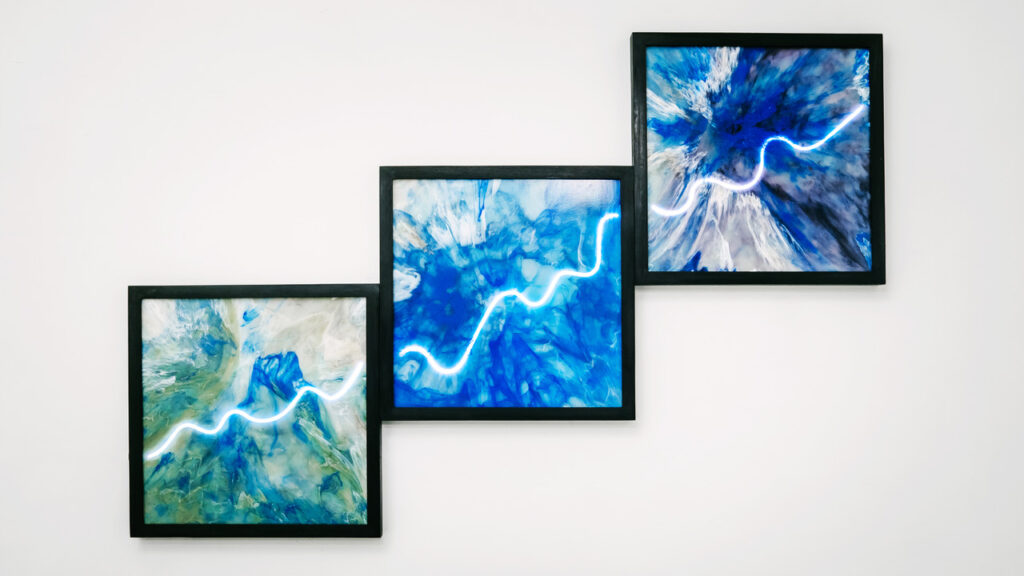
Image: Aphra Shemza, Ocean Rise V, 2022. Photography by Matthew Kaltenborn.
Publishing, accessible workshops and peer learning
Alongside developing my practical skills I have also published details about how artists can be more sustainable through Artquest and on the 22nd April 2022 (Earth Day) we will publish a best practice guide for plastic recycling through the Centre for Sustainable Practice in the Arts.
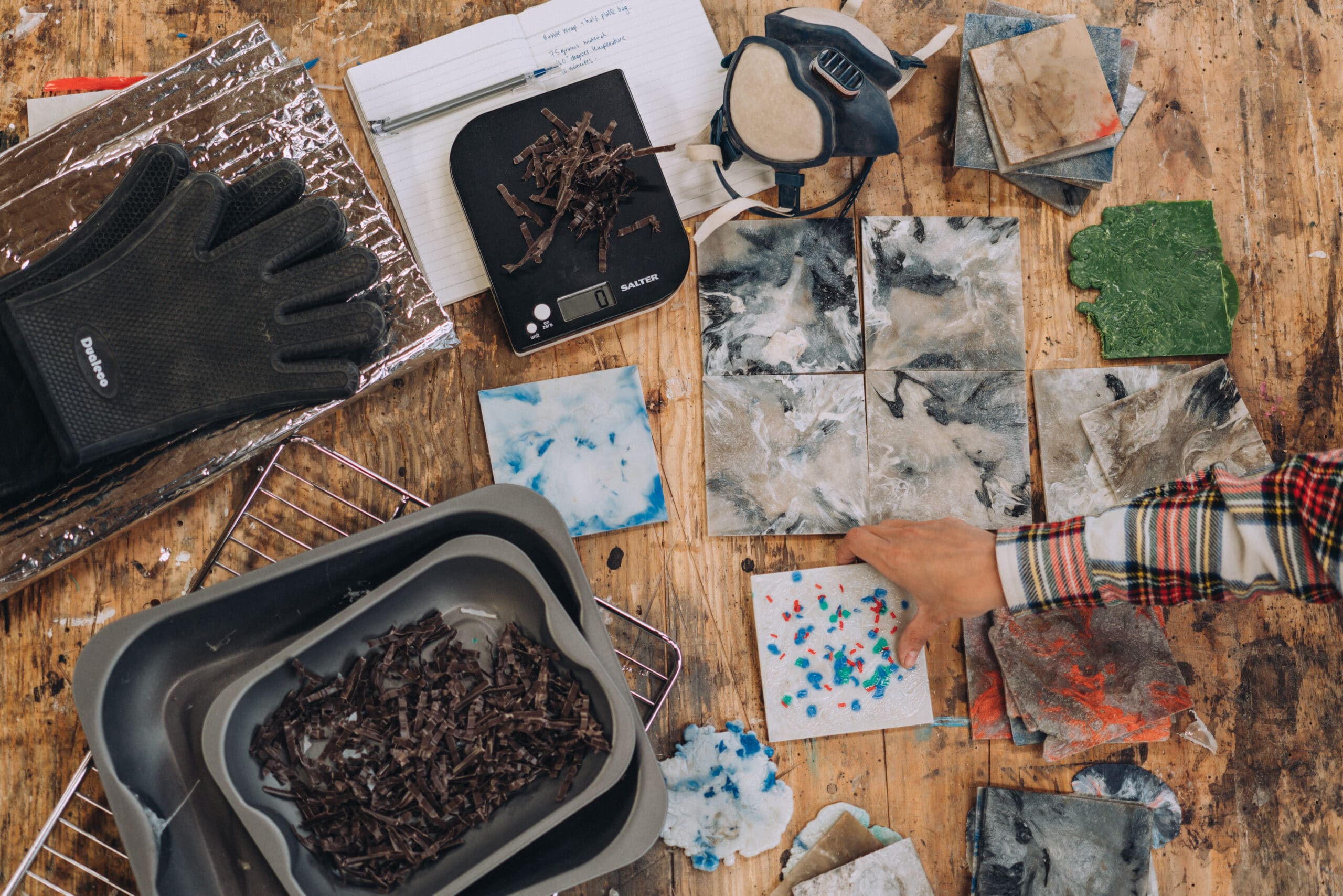
Image: Aphra Shemza in the studio recycling plastic. Photography by Claudia Agati.
I am also passionate about sharing my knowledge and skills with everyone. I have developed accessible plastic recycling workshop content for all, including children and adults with specific needs, making sustainable practice available to all. I will be running these workshops later this year. I have hosted the Art in Flux: Sustainable media art social event for artists working with technology and run two lectures for MA Art and Science students from Central Saint Martins and Goldsmiths MA Computational Art students.
Through my work in this area, I have found that it is really important to share with others and develop peer and public networks in order to make change happen. In 2016 I co-founded Art in Flux alongside my colleagues and artists Maria Almena and Olive Gingrich. Art in Flux is a community interest company committed to furthering the development of the media arts through public programmes. Through this network I have been able to reach the public via our residency with the National Gallery X and exhibitions and talks events. I have also actively found supporters and partners by researching others and connecting. I have found that experts working in this area are more than happy to have a chat and share their knowledge and connections with a like-minded individual.
So how can you be more sustainable in your own artistic practice?
I have produced a website for artists working with technology. It helps you to be more mindful about sustainable approaches. The site has a lot of in depth research about electronic hardware: www.art-ology.co.uk
The following resources propose ways of thinking about sustainability at the point of development. They are structured around the themes of Materials, Energy, Transport and Conservation. This excerpt was first commissioned by Artquest for our Sustainable Art Practice article:
Materials
Actions
- Look at the materials that you need to make your work and create a list.
- Do some research about each material. How sustainable is it? Give it a score from 1-10. Look at how it is produced? Where is it made and from what? Does it produce fumes? Is it shipped from far away?
- Once you have your list look at the materials that scored the lowest. Research into more sustainable alternatives. Start switching your materials over.
- If you can’t swap a material because it is integral to your practice can you source it locally to save on fuel? Or can you work with a local fabricator who has a sustainability policy to make your work?
- Think about the waste that you create when making the work. If you are working with oil paint can you reuse the tubes to make other works or find another artist who can? Can you donate it to others or recycle at a recycling centre?
Tips
- Working with paper? Try recycled paper e.g. Economy of Brighton.
- Working with paint? Try reclaimed paint from a local paint store e.g. Forest Recycling Project ”. Buy items from Great Art and return the empties for recycling.
- Working with resin? Try Bio Resin.
- Working with MDF? Try Eco-board or plywood.
- Working with Perspex? Try recycled plastic e.g. The Good Plastic Company or Green Cast.
- Or recycle your own plastic waste e.g. Precious Plastics.
- Working with wood? Try reclaimed timber e.g. Saunders Seasonings.
Energy
Actions
- Does your work need energy to power it? Can it plug into a green energy supplier at source?
- If not, write down a list of your components and how much power they consume.
- Look at how you could reduce consumption and implement this.
Tips
- Using LED technology? Try 30 LEDs per metre rather than the standard 60 as this cuts down on wattage.
- Using light? Try reflective materials instead of many light sources.
- Using electronic devices? Use a timer switch to make sure the equipment turns off overnight.
- Using projectors or screens? Hire the equipment rather than buy it so that it can be reused.
Transport
Actions
- Could your artwork be smaller and save on transport and materials? Or can it be modular so that it can travel light?
- Can you use a local company to supply your materials?
- Can you share a van or vehicle with other artists to save on petrol costs
- Can you use a bicycle courier to get your work from A-B?
Tips
Conservation
There has been a lot of research done by museums and institutions about how to conserve an artwork. Artists should consider how their work can be conserved before they make it. It is important to think about conservation because maintaining and repairing an artwork over the course of its lifetime leads to less waste in the long term and makes your work more collectible.
Actions
- Create a passport of materials that travels with the artwork when sold. This should list all the materials used to make the work. It should include information on what parts are replaceable or irreplaceable from the artist’s point of view.
- If your work uses electronic or specialised materials, keep a box of spares in case repairs are necessary. You could even consider selling the work with a box of spares that travels with the piece as it changes owners.
- Think about the lifespan of your work and make a plan for the conservation of that piece with the buyer.
Tips
- If you are a painter you are lucky as your work will need little conservation in your lifetime. Consider your framing. Use UV glass to protect the piece long term. Suggest the client avoid hanging work in direct sunlight as it could fade.
- When making public sculpture create a maintenance agreement. This should outline the plan for looking after the work moving forwards.
- If you work with neon, this will need servicing at least every 3 years. Make sure that your clients are aware of this and write this into a point of sale contract. Give repairs for free for a certain period of time. After that charge a reasonable rate to repair them if needed moving forward.
- Collectors want to look after the work they buy. Don’t be afraid to discuss this with your client. Be transparent and do what is best for the artwork.
Conclusion
The climate crisis can feel overwhelming at times and that is why we should focus on what we CAN do rather than what we CAN’T. I believe if we each look after our own corner of the world, our actions can combine to create the change that we wish to see in the world. Not only does moving towards a more sustainable practice feel satisfying, it is also helping to protect our planet. By working together we can create a greener future for current and future generations.
You can see more of Aphra’s work on her website here.
All imagery supplied by Aphra Shemza

